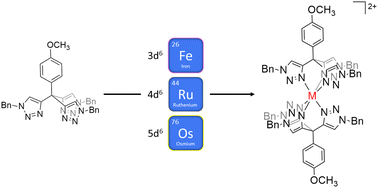Synthesis and characterisation of group 8 tris(1-benzyl-1,2,3-triazol-4-yl)-p-anisolylmethane complexes†
Abstract
The tris(1,2,3-triazol-4-yl)methane framework offers a highly versatile architecture for ligand design, yet the coordination chemistry of this class of ligand remains largely unexplored. We report here the synthesis and characterisation of the homoleptic complexes [M(ttzm)2](PF6)2 (ttzm = tris(1-benzyl-1,2,3-triazol-4-yl)-p-anisolylmethane; M = Fe (Fe), Ru (Ru), Os (Os)). Initial attempts to prepare Ru by reaction of [Ru(p-cymene)Cl2]2 and ttzm also led to the isolation of the heteroleptic complex [Ru(p-cymene)(ttzm)](PF6)2. The structures of [Ru(p-cymene)(ttzm)](PF6)2, [Fe(ttzm)2]2+ (as its BPh4− salt) and Os were solved by X-ray diffraction. The homoleptic Fe(II) and Os(II) containing cations adopt distorted octahedral geometries due to the steric interactions between the ansiole and triazole rings of the ttzm ligands. The homoleptic complexes all adopt a low-spin d6 configuration and exhibit reversible M(II)/M(III) processes (+0.35 to +0.72 V vs. Fc/Fc+). These oxidation processes are cathodically shifted relative to those of related hexatriazole donor based complexes with density functional theory (DFT) calculations showing the metal d-orbitals are destabilised through a π-donor contribution from the triazole rings. The complexes all show prominent UV-visible absorption bands between 350 and 450 nm assigned to transitions of 1MLCT character. Whilst none of the homoleptic complexes are emissive in room temperature fluid solutions, Os is emissive at 77 K in an EtOH/MeOH glass (λmax 472 nm).



 Please wait while we load your content...
Please wait while we load your content...